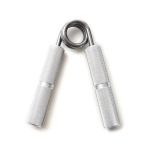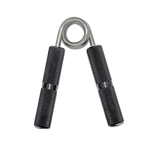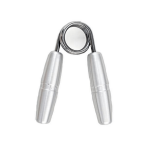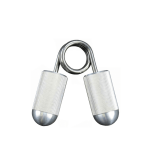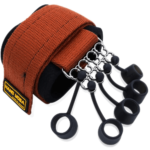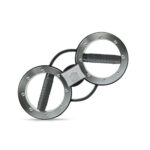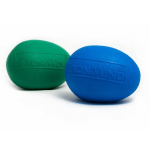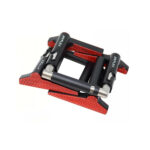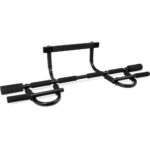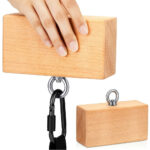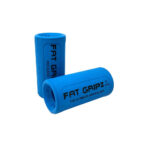(Last Updated on March 13, 2025 by Henry)
I frequently hear people discuss the importance of core strength or cardiovascular health. It’s not as common to hear about the role of grip strength, but it’s time to shine a light on this unsung hero of fitness and daily function. Personally, I’ve found that a firm grip can open doors, literally and metaphorically, to improved quality of life and athletic performance.
Striving towards a goal can revolutionize your exercise routine. When motivation starts to flicker, setting challenges acts as a robust beacon, guiding you to measurable advancements. Whether you’re aiming to best your personal records or preparing for competitions, the drive to overcome hurdles maintains a steady pace on the road to success.
This blog post is a treasure trove of insights on grip strength, brimming with challenges tailored to various skill levels. I’ll take you through why grip strength warrants attention, how to scale your challenges from simple to strenuous, and how maintaining this critical aspect of fitness can bolster your daily activities and sport-specific skills. Let’s embark on this gripping journey, ready your resolve, and prepare to uncover the benefits that await you.

Grasping Grip Strength: Foundations and Advantages
When I mention grip strength, what comes to mind? Perhaps it’s the image of a firm handshake or the sensation of holding onto weights at the gym. But grip strength encompasses much more than a momentary squeeze. It’s a composite of various muscles working together across your hands, wrists, and forearms.
In this section, you’ll learn it’s not just about the strength in a single clutch but includes three distinct types: the crush grip used for grasping objects like a tennis racket, the pinch grip crucial for holding onto thin plates, and the support grip needed for endurance tasks like carrying heavy bags.
The merits of enhancing your grip may not be immediately noticeable yet they are substantial. For one, if you’re involved in sports, you’ll find an improvement in performance. Whether you’re swinging a bat, gripping a golf club, or tackling an opponent in football, a stronger grip can elevate your game. Furthermore, a sturdy grip is akin to an insurance policy against common injuries, safeguarding tendons and muscles from the wear and tear of repetitive tasks.
Not confined to the domain of athletics, a stronger grip can redefine your everyday life. Picture this: jars open more easily, moving furniture becomes less of a hassle, and even typing can feel more comfortable. With a strengthened grip, you’re gearing your hands to overcome small but significant obstacles throughout your day. This means less strain and a smoother ride through both your work and personal life.
Now that I’ve set the stage, understanding the why and what of grip strength, let’s prepare to delve into crafting your own grip strength regimen. Tailoring your journey to strengthen your grip begins with meticulous planning and goal setting—an exciting step that’s up next.
Tailoring Your Grip Strength Quest
I’ve found that setting goals is akin to drawing a map for a treasure hunt. Without it, you’re just wandering aimlessly, hoping to stumble upon success. When it comes to improving your grip strength, setting clear, well-defined challenges is CRITICAL. It provides direction, motivation, and a sense of achievement as you mark off milestones along your journey.
Before leaping into challenges, assess where you stand. Your CURRENT FITNESS LEVEL sets the stage. Are you a gym regular, or is this a starting point? Your SPECIFIC GOALS also shape your path. Are you aiming to improve performance in a sport, or is it about overall fitness? And let’s not overlook the equipment you have at your disposal—an essential factor in devising your challenges.
But here’s a KEY TIP: Balance ambition with realism. Challenges should stretch your abilities without breaking your spirit. They should be tailored to be JUST beyond your current reach, nudging you forward but remaining achievable. It’s a fine line but an important one to find.
Grip Strength Milestones for Beginners
The journey to building a firm grip begins with acknowledging your starting point and setting sights on achievable milestones that signal progress. For beginners, mastering the basics of grip strength can be both exhilarating and critical to unlocking potential in many endeavors. It’s essential to start with low-intensity, high-repetition exercises to condition the muscles and tendons gradually. Here are three starter challenges designed to establish your grip foundation:
Stress ball squeeze: Begin with a simple stress ball. I recommend starting with sets of squeezing it firmly for two minutes. It’s more than just a stress-reliever; this repetitive action promotes muscle endurance and blood flow to the fingers, palms, and forearms, setting the stage for more complex challenges.
Time-test with a dumbbell: Grab a dumbbell of a weight that feels challenging but manageable. Hold it at your side and time how long you can maintain a firm grip. Keep your arm static and avoid using your body to compensate as the weight starts to feel heavier over time. Record your time and aim to increase it with regular practice. This exercise is a fantastic way to measure your improving endurance and raw holding capability.
Hanging leg raises: These aren’t just for your abs. Hang from a pull-up bar with a firm, shoulder-width grip. Perform leg raises while maintaining this hold. Starting with ten repetitions can go a long way toward increasing your grip strength as well as core stability. When it’s done consistently, you’ll be surprised at how quickly your hang time increases.
As you move to the next stage, the focus will shift from simply hanging on to actively supporting more complex movements. In the Intermediate Grip Strength Challenges, you’ll find tasks that build on these foundational practices. Your grip will be tested further as you add movement, weight, and new dimensions to your grip training plan.
Raising the Bar: Intermediate Grip Challenges
Once you’ve built a solid foundation with beginner challenges, it’s time to step up your grip game. These intermediate challenges are designed to push your strength, endurance, and mental grit to new levels.
Begin with the Farmer’s Walk. It’s straightforward—lift heavy weights in each hand and walk. The challenge lies in the distance. Start with a distance you can manage, and gradually increase it each session. Keep your back straight and shoulders back, and walk with intent.

Next, let’s conquer the Plate Pinch. Grab a pair of weight plates and pinch them together with fingers and thumbs on opposite sides.
Stand tall and hold. Begin with a moderate time, like 15 seconds, and strive to add time as you grow stronger.
The Dead Hang challenge requires nothing more than a sturdy pull-up bar and willpower.
Grasp the bar with an overhand grip, arms fully extended, and your feet off the ground.
Set your timer and aim for a full minute. Combat the urge to let go, focusing on deep breaths and a relaxed posture.
These tasks will not only enhance your grip but will also amplify overall body strength and mental fortitude. Every session will inch you closer to your personal best—just be mindful not to sacrifice form for time or distance.
It’s crucial to note the importance of recovery. As you push through these intermediate challenges, make sure to give your muscles the rest they need. This investment in recovery today will enhance your performance tomorrow.
The Elite Grip Gauntlet: Advanced Challenges
If you’ve sailed past the introductory exercises and cruised through the intermediate trials, it’s time for grander ambitions. Stepping into advanced grip strength challenges means you’re ready to test your mettle against some truly demanding tasks. These challenges are not just about holding on; they’re about pushing your limits and discovering the raw power in your hands.
Challenge one, the One-Arm Dead Hang, is as tough as it sounds. Hanging from a bar with a single arm is an ultimate feat, metals your endurance, and bolters both grip and overall upper body strength. Start by aiming for a few seconds and gradually, with grit, extend your time.
Up next are the Towel Pull-Ups. These are no ordinary pull-ups. Throw a towel over the bar, grip both ends, and pull yourself up. The shifting and rolling of the towel material amplifies the challenge, ensuring that every pull-up is an intensive grip workout.
Lastly, Fingertip Push-Ups call for not just grip strength, but also touch on your finger’s explosive power and control. With only fingertips touching the ground, the focus is to perform full push-ups without compromising form. These are difficult and might take time to master – patience is KEY.
Sure, these exercises are demanding, but the results are undeniable. They forge a level of grip strength that not only benefits your lifts but invades every aspect of your fitness routine with vigor.
Inventive Grip Strength Challenges for the Creative Gripper
Sometimes, stepping outside the confines of conventional workouts can launch your progress into overdrive. Creative challenges not only break the monotony but also engage your muscles in novel ways that foster rapid development. In this section, we explore activities that pack a punch for your grip strength while providing a hefty dose of excitement.
Rock climbing and boulder scrambling, for starters, offer a dynamic workout that targets every muscle in your hands and forearms. Beyond building muscle, these activities improve problem-solving skills as you find your next hold. If you’re new to the climbing wall, sign up for an introductory class or find a local group to guide you.
Then there’s obstacle course racing (OCR). Races like the Spartan Race or Tough Mudder are more than mere competitions; they’re full-fledged adventures that challenge every facet of physical fitness, grip included. You’ll hoist yourself over walls, swing across monkey bars, and clamber up ropes, igniting a fire in your forearms that you never knew existed.
Lastly, consider grip strength competitions. These contests are not just for the elite; they provide a tangible goal to work towards for all levels. Events like the Armlifting World Championship put your grip to the test against various implements, offering you a stage to showcase the fruits of your labor.
Now, with these creative grip challenges in mind, it’s equally important to keep a finger on the pulse of your progress. That’s where the next section comes into play, where we’ll discuss the best ways to track your improvements. Having your achievements clearly laid out can be the difference between stagnation and a steadfast march towards grip glory.
Grip It: Monitoring Your Powerful Progress
You might not see grip strength improvements with a casual glance in the mirror, but mark my words, they’re critical to your overall fitness. It’s essential to keep a detailed log of your progress. This log helps you understand what works, what doesn’t, and how far you’ve come.
There are various ways to track your achievements. Something as simple as a notebook can serve as your grip training diary. But in this digital age, why not use a smartphone app dedicated to tracking your weights, reps, and holds? Many apps also have built-in timers and progress graphs.
How do you know if you’re really getting stronger? It’s more than just intuition. Record the max weight you can hold, the longest hang time, or the number of plate pinches you achieve each session. Over time, these numbers should trend upwards. Even small increments are victories in their own right.

Now, hold that thought as we transition into the strategies that will keep your grip—and your spirits—firmly solid. I’m talking about motivation, which isn’t just about raw determination. It’s also about savvy strategies and community support. Up next, we’ll explore how to stay gripped to your goals.
Grasp the Endgame: A Gripping Conclusion
As we close this chapter on grip strength challenges, it’s essential to reflect on the lessons learned and the strength gained – both in our hands and in our resolve.
From squeezing stress balls as a beginner to conquering one-arm hanging challenges as an advanced gripper, the journey towards a stronger grip is marked by personal milestones, determination, and the rewards of seeing your capabilities grow.
Consider this post not just as a guide, but as a starting signal for your own gripping quest. Set challenges that push you, yet are tailored to your current abilities and goals. Remember, the key to gripping success is persistence. It won’t happen overnight, but with regular effort, progress is inevitable.
Stay consistent in your training, maintain the right form, and most importantly, listen to your body to prevent overtraining. Mix up your routines to keep things interesting and to challenge your muscles in new ways. And don’t forget to look after your overall hand health – after all, your hands are the tools that will carry you through every gripping challenge you meet.
With the strategies and advice from the previous sections in hand, you’re now equipped to set out on a path that will not only enhance your grip strength but also spill over into improving your performance in sports, daily activities, and overall fitness.
Take the first step, embrace the perseverance required, and enjoy the tangible and satisfying feeling of a firmer handshake, sturdier hold, and the confidence that comes from knowing you have a grip that won’t let you down when you need it the most.
Thanks for Stopping By
Have Questions?
Please Leave A Comment

